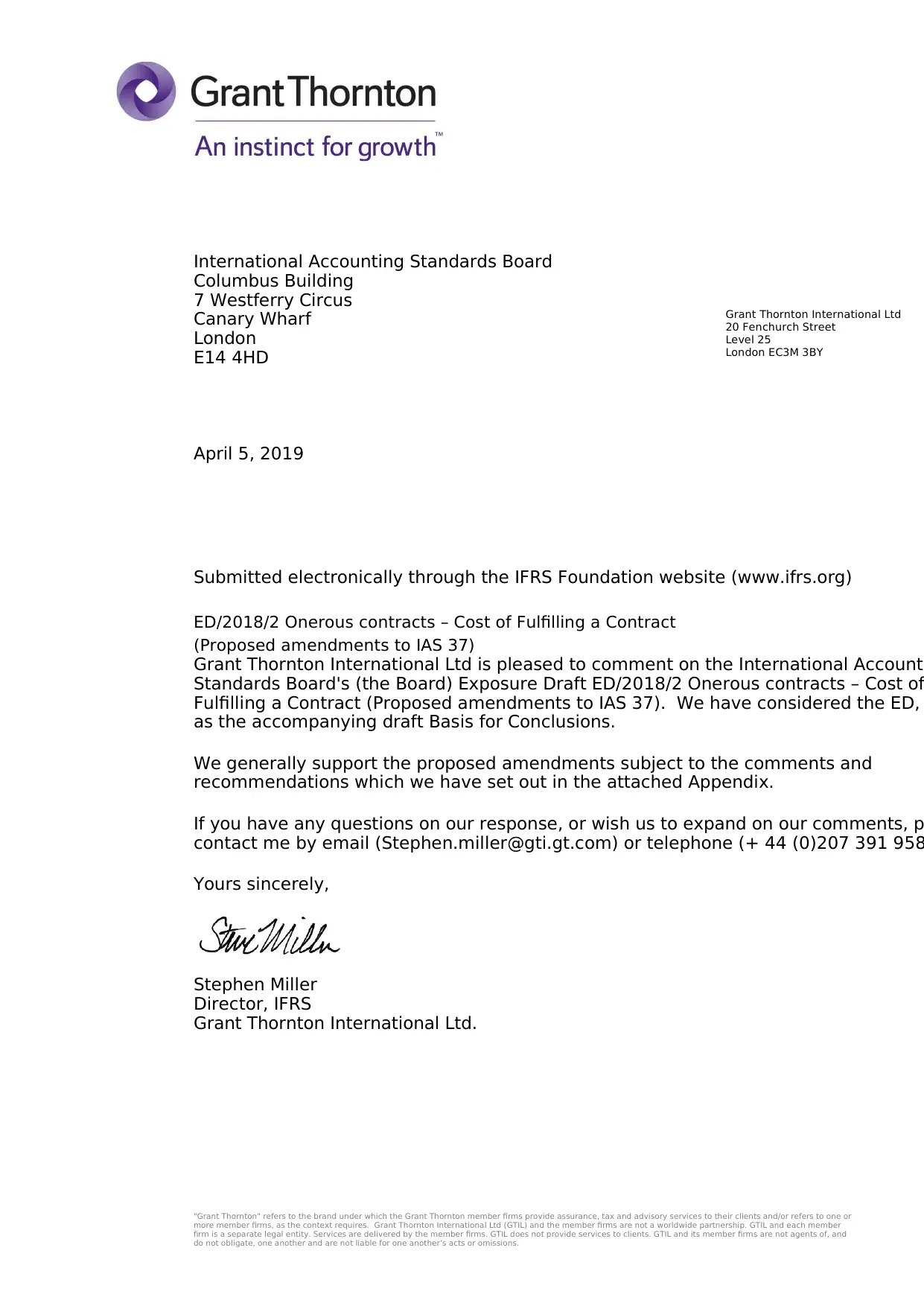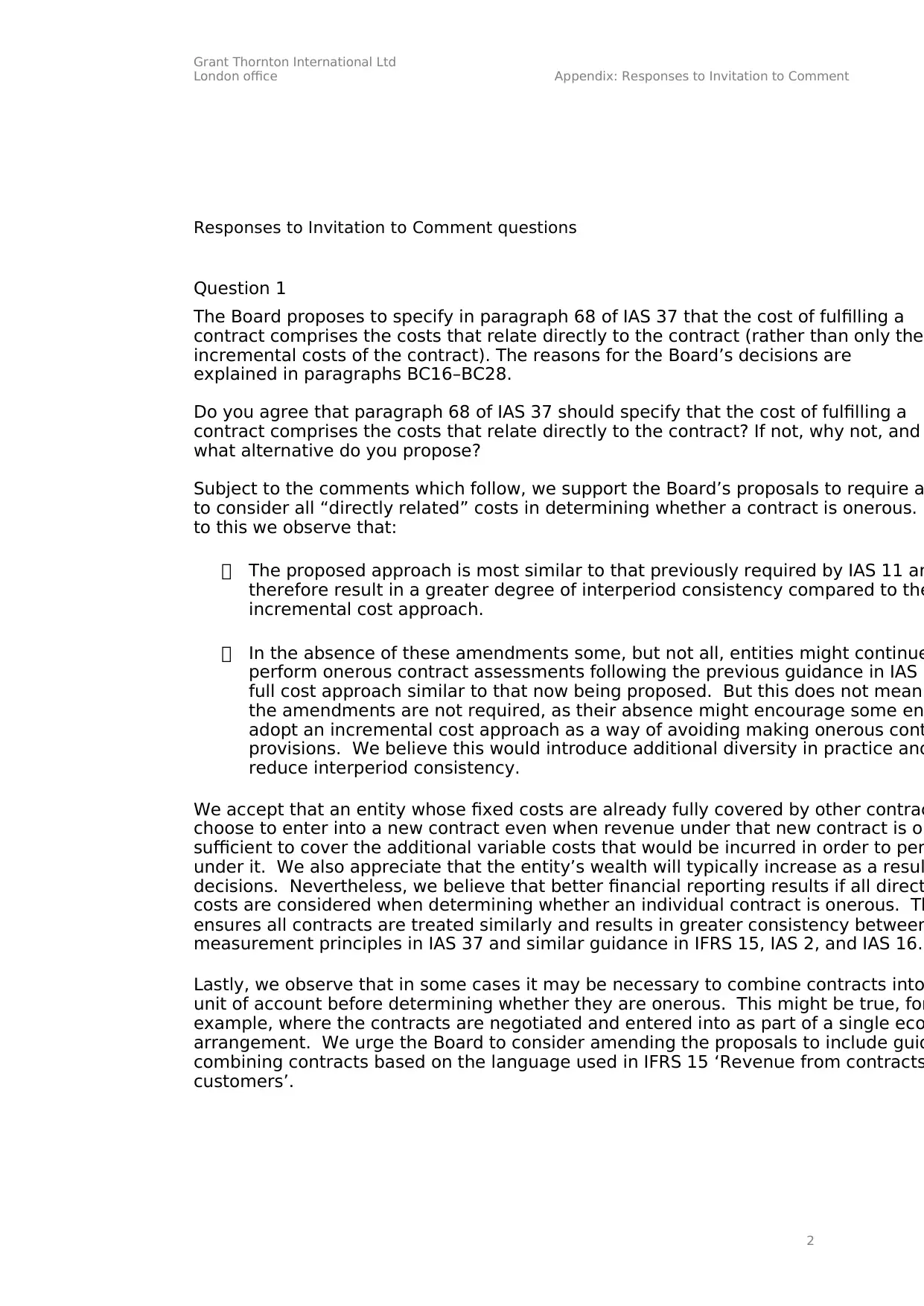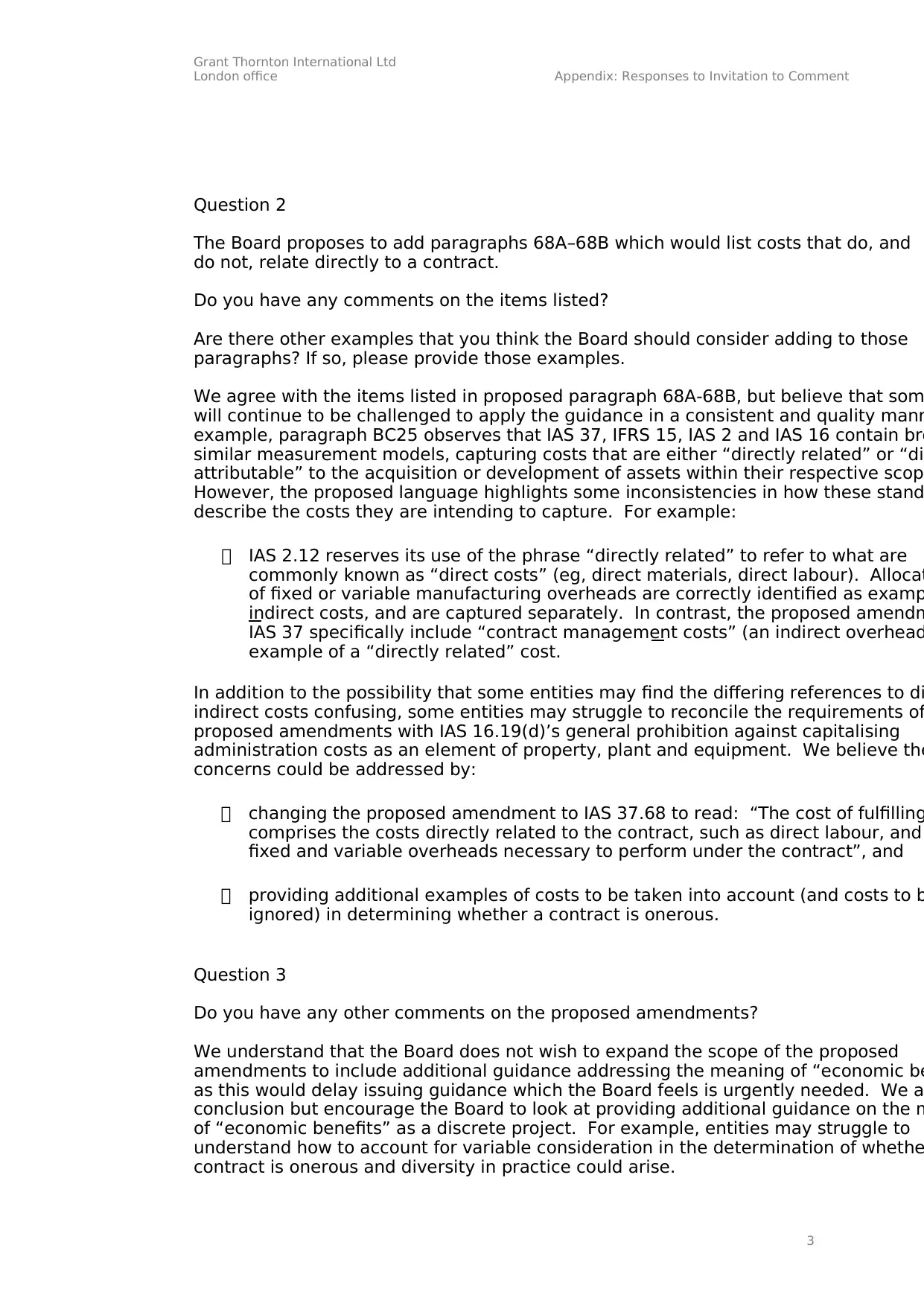Detailed Analysis of IAS 37 Onerous Contracts Amendments and Responses
VerifiedAdded on 2023/03/17
|3
|1307
|84
Report
AI Summary
This document presents Grant Thornton International Ltd's response to the International Accounting Standards Board's (IASB) Exposure Draft ED/2018/2, which concerns the proposed amendments to IAS 37 regarding onerous contracts and the cost of fulfilling a contract. The response addresses the Board's questions, supporting the specification that the cost of fulfilling a contract comprises costs directly related to the contract. It provides detailed observations on the proposed amendments, including concerns about consistency with other standards like IAS 2, IFRS 15, and IAS 16. Grant Thornton suggests clarifications on the definition of 'directly related' costs and recommends additional guidance on combining contracts and the meaning of 'economic benefits' to ensure consistent application and high-quality financial reporting. The report includes specific recommendations for the Board's consideration to address potential inconsistencies and improve the clarity of the proposed amendments.

"Grant Thornton" refers to the brand under which the Grant Thornton member firms provide assurance, tax and advisory services to their clients and/or refers to one or
more member firms, as the context requires. Grant Thornton International Ltd (GTIL) and the member firms are not a worldwide partnership. GTIL and each member
firm is a separate legal entity. Services are delivered by the member firms. GTIL does not provide services to clients. GTIL and its member firms are not agents of, and
do not obligate, one another and are not liable for one another’s acts or omissions.
International Accounting Standards Board
Columbus Building
7 Westferry Circus
Canary Wharf
London
E14 4HD
April 5, 2019
Submitted electronically through the IFRS Foundation website (www.ifrs.org)
ED/2018/2 Onerous contracts – Cost of Fulfilling a Contract
(Proposed amendments to IAS 37)
Grant Thornton International Ltd is pleased to comment on the International Accounti
Standards Board's (the Board) Exposure Draft ED/2018/2 Onerous contracts – Cost of
Fulfilling a Contract (Proposed amendments to IAS 37). We have considered the ED,
as the accompanying draft Basis for Conclusions.
We generally support the proposed amendments subject to the comments and
recommendations which we have set out in the attached Appendix.
If you have any questions on our response, or wish us to expand on our comments, p
contact me by email (Stephen.miller@gti.gt.com) or telephone (+ 44 (0)207 391 958
Yours sincerely,
Stephen Miller
Director, IFRS
Grant Thornton International Ltd.
Grant Thornton International Ltd
20 Fenchurch Street
Level 25
London EC3M 3BY
more member firms, as the context requires. Grant Thornton International Ltd (GTIL) and the member firms are not a worldwide partnership. GTIL and each member
firm is a separate legal entity. Services are delivered by the member firms. GTIL does not provide services to clients. GTIL and its member firms are not agents of, and
do not obligate, one another and are not liable for one another’s acts or omissions.
International Accounting Standards Board
Columbus Building
7 Westferry Circus
Canary Wharf
London
E14 4HD
April 5, 2019
Submitted electronically through the IFRS Foundation website (www.ifrs.org)
ED/2018/2 Onerous contracts – Cost of Fulfilling a Contract
(Proposed amendments to IAS 37)
Grant Thornton International Ltd is pleased to comment on the International Accounti
Standards Board's (the Board) Exposure Draft ED/2018/2 Onerous contracts – Cost of
Fulfilling a Contract (Proposed amendments to IAS 37). We have considered the ED,
as the accompanying draft Basis for Conclusions.
We generally support the proposed amendments subject to the comments and
recommendations which we have set out in the attached Appendix.
If you have any questions on our response, or wish us to expand on our comments, p
contact me by email (Stephen.miller@gti.gt.com) or telephone (+ 44 (0)207 391 958
Yours sincerely,
Stephen Miller
Director, IFRS
Grant Thornton International Ltd.
Grant Thornton International Ltd
20 Fenchurch Street
Level 25
London EC3M 3BY
Paraphrase This Document
Need a fresh take? Get an instant paraphrase of this document with our AI Paraphraser

Grant Thornton International Ltd
London office Appendix: Responses to Invitation to Comment
2
Responses to Invitation to Comment questions
Question 1
The Board proposes to specify in paragraph 68 of IAS 37 that the cost of fulfilling a
contract comprises the costs that relate directly to the contract (rather than only the
incremental costs of the contract). The reasons for the Board’s decisions are
explained in paragraphs BC16–BC28.
Do you agree that paragraph 68 of IAS 37 should specify that the cost of fulfilling a
contract comprises the costs that relate directly to the contract? If not, why not, and
what alternative do you propose?
Subject to the comments which follow, we support the Board’s proposals to require a
to consider all “directly related” costs in determining whether a contract is onerous.
to this we observe that:
The proposed approach is most similar to that previously required by IAS 11 an
therefore result in a greater degree of interperiod consistency compared to the
incremental cost approach.
In the absence of these amendments some, but not all, entities might continue
perform onerous contract assessments following the previous guidance in IAS 1
full cost approach similar to that now being proposed. But this does not mean
the amendments are not required, as their absence might encourage some en
adopt an incremental cost approach as a way of avoiding making onerous cont
provisions. We believe this would introduce additional diversity in practice and
reduce interperiod consistency.
We accept that an entity whose fixed costs are already fully covered by other contrac
choose to enter into a new contract even when revenue under that new contract is on
sufficient to cover the additional variable costs that would be incurred in order to per
under it. We also appreciate that the entity’s wealth will typically increase as a resul
decisions. Nevertheless, we believe that better financial reporting results if all direct
costs are considered when determining whether an individual contract is onerous. Th
ensures all contracts are treated similarly and results in greater consistency between
measurement principles in IAS 37 and similar guidance in IFRS 15, IAS 2, and IAS 16.
Lastly, we observe that in some cases it may be necessary to combine contracts into
unit of account before determining whether they are onerous. This might be true, for
example, where the contracts are negotiated and entered into as part of a single eco
arrangement. We urge the Board to consider amending the proposals to include guid
combining contracts based on the language used in IFRS 15 ‘Revenue from contracts
customers’.
London office Appendix: Responses to Invitation to Comment
2
Responses to Invitation to Comment questions
Question 1
The Board proposes to specify in paragraph 68 of IAS 37 that the cost of fulfilling a
contract comprises the costs that relate directly to the contract (rather than only the
incremental costs of the contract). The reasons for the Board’s decisions are
explained in paragraphs BC16–BC28.
Do you agree that paragraph 68 of IAS 37 should specify that the cost of fulfilling a
contract comprises the costs that relate directly to the contract? If not, why not, and
what alternative do you propose?
Subject to the comments which follow, we support the Board’s proposals to require a
to consider all “directly related” costs in determining whether a contract is onerous.
to this we observe that:
The proposed approach is most similar to that previously required by IAS 11 an
therefore result in a greater degree of interperiod consistency compared to the
incremental cost approach.
In the absence of these amendments some, but not all, entities might continue
perform onerous contract assessments following the previous guidance in IAS 1
full cost approach similar to that now being proposed. But this does not mean
the amendments are not required, as their absence might encourage some en
adopt an incremental cost approach as a way of avoiding making onerous cont
provisions. We believe this would introduce additional diversity in practice and
reduce interperiod consistency.
We accept that an entity whose fixed costs are already fully covered by other contrac
choose to enter into a new contract even when revenue under that new contract is on
sufficient to cover the additional variable costs that would be incurred in order to per
under it. We also appreciate that the entity’s wealth will typically increase as a resul
decisions. Nevertheless, we believe that better financial reporting results if all direct
costs are considered when determining whether an individual contract is onerous. Th
ensures all contracts are treated similarly and results in greater consistency between
measurement principles in IAS 37 and similar guidance in IFRS 15, IAS 2, and IAS 16.
Lastly, we observe that in some cases it may be necessary to combine contracts into
unit of account before determining whether they are onerous. This might be true, for
example, where the contracts are negotiated and entered into as part of a single eco
arrangement. We urge the Board to consider amending the proposals to include guid
combining contracts based on the language used in IFRS 15 ‘Revenue from contracts
customers’.

Grant Thornton International Ltd
London office Appendix: Responses to Invitation to Comment
3
Question 2
The Board proposes to add paragraphs 68A–68B which would list costs that do, and
do not, relate directly to a contract.
Do you have any comments on the items listed?
Are there other examples that you think the Board should consider adding to those
paragraphs? If so, please provide those examples.
We agree with the items listed in proposed paragraph 68A-68B, but believe that som
will continue to be challenged to apply the guidance in a consistent and quality mann
example, paragraph BC25 observes that IAS 37, IFRS 15, IAS 2 and IAS 16 contain bro
similar measurement models, capturing costs that are either “directly related” or “di
attributable” to the acquisition or development of assets within their respective scop
However, the proposed language highlights some inconsistencies in how these stand
describe the costs they are intending to capture. For example:
IAS 2.12 reserves its use of the phrase “directly related” to refer to what are
commonly known as “direct costs” (eg, direct materials, direct labour). Allocat
of fixed or variable manufacturing overheads are correctly identified as examp
indirect costs, and are captured separately. In contrast, the proposed amendm
IAS 37 specifically include “contract management costs” (an indirect overhead
example of a “directly related” cost.
In addition to the possibility that some entities may find the differing references to di
indirect costs confusing, some entities may struggle to reconcile the requirements of
proposed amendments with IAS 16.19(d)’s general prohibition against capitalising
administration costs as an element of property, plant and equipment. We believe the
concerns could be addressed by:
changing the proposed amendment to IAS 37.68 to read: “The cost of fulfilling
comprises the costs directly related to the contract, such as direct labour, and
fixed and variable overheads necessary to perform under the contract”, and
providing additional examples of costs to be taken into account (and costs to b
ignored) in determining whether a contract is onerous.
Question 3
Do you have any other comments on the proposed amendments?
We understand that the Board does not wish to expand the scope of the proposed
amendments to include additional guidance addressing the meaning of “economic be
as this would delay issuing guidance which the Board feels is urgently needed. We a
conclusion but encourage the Board to look at providing additional guidance on the m
of “economic benefits” as a discrete project. For example, entities may struggle to
understand how to account for variable consideration in the determination of whethe
contract is onerous and diversity in practice could arise.
London office Appendix: Responses to Invitation to Comment
3
Question 2
The Board proposes to add paragraphs 68A–68B which would list costs that do, and
do not, relate directly to a contract.
Do you have any comments on the items listed?
Are there other examples that you think the Board should consider adding to those
paragraphs? If so, please provide those examples.
We agree with the items listed in proposed paragraph 68A-68B, but believe that som
will continue to be challenged to apply the guidance in a consistent and quality mann
example, paragraph BC25 observes that IAS 37, IFRS 15, IAS 2 and IAS 16 contain bro
similar measurement models, capturing costs that are either “directly related” or “di
attributable” to the acquisition or development of assets within their respective scop
However, the proposed language highlights some inconsistencies in how these stand
describe the costs they are intending to capture. For example:
IAS 2.12 reserves its use of the phrase “directly related” to refer to what are
commonly known as “direct costs” (eg, direct materials, direct labour). Allocat
of fixed or variable manufacturing overheads are correctly identified as examp
indirect costs, and are captured separately. In contrast, the proposed amendm
IAS 37 specifically include “contract management costs” (an indirect overhead
example of a “directly related” cost.
In addition to the possibility that some entities may find the differing references to di
indirect costs confusing, some entities may struggle to reconcile the requirements of
proposed amendments with IAS 16.19(d)’s general prohibition against capitalising
administration costs as an element of property, plant and equipment. We believe the
concerns could be addressed by:
changing the proposed amendment to IAS 37.68 to read: “The cost of fulfilling
comprises the costs directly related to the contract, such as direct labour, and
fixed and variable overheads necessary to perform under the contract”, and
providing additional examples of costs to be taken into account (and costs to b
ignored) in determining whether a contract is onerous.
Question 3
Do you have any other comments on the proposed amendments?
We understand that the Board does not wish to expand the scope of the proposed
amendments to include additional guidance addressing the meaning of “economic be
as this would delay issuing guidance which the Board feels is urgently needed. We a
conclusion but encourage the Board to look at providing additional guidance on the m
of “economic benefits” as a discrete project. For example, entities may struggle to
understand how to account for variable consideration in the determination of whethe
contract is onerous and diversity in practice could arise.
⊘ This is a preview!⊘
Do you want full access?
Subscribe today to unlock all pages.

Trusted by 1+ million students worldwide
1 out of 3
Related Documents
Your All-in-One AI-Powered Toolkit for Academic Success.
+13062052269
info@desklib.com
Available 24*7 on WhatsApp / Email
![[object Object]](/_next/static/media/star-bottom.7253800d.svg)
Unlock your academic potential
Copyright © 2020–2025 A2Z Services. All Rights Reserved. Developed and managed by ZUCOL.





